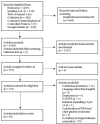Kidney disease in adults with Prader-Willi syndrome: international cohort study and systematic literature review
- PMID: 37547314
- PMCID: PMC10402738
- DOI: 10.3389/fendo.2023.1168648
Kidney disease in adults with Prader-Willi syndrome: international cohort study and systematic literature review
Erratum in
-
Corrigendum: Kidney disease in adults with Prader-Willi syndrome: international cohort study and systematic literature review.Front Endocrinol (Lausanne). 2024 Jan 22;15:1357219. doi: 10.3389/fendo.2024.1357219. eCollection 2024. Front Endocrinol (Lausanne). 2024. PMID: 38318297 Free PMC article.
Abstract
Background: Prader-Willi syndrome (PWS) is a rare, complex, genetic disorder characterized by hyperphagia, hypotonia, delayed psychomotor development, low muscle mass and hypothalamic dysfunction. Adults with PWS often have obesity, hypertension and type 2 diabetes mellitus (DM2), known risk factors for cardiovascular disease (CVD) and chronic kidney disease (CKD). Early symptoms of CVD and CKD may be masked by intellectual disability and inability to express physical complaints. Furthermore, kidney diseases are often asymptomatic. Therefore, renal and cardiovascular disease might be missed in patients with PWS. Microalbuminuria is an early sign of microvascular damage in the kidneys and other vascular beds. Therefore, we screened our adult PWS cohort for the presence of elevated urinary albumin and (micro)albuminuria.
Methods: We retrospectively collected anthropometric measurements, blood pressure, medical history, medication use, urine dipstick and biochemical measurements form electronic patient files. In addition, we performed a systematic literature review on kidney disease in PWS.
Results: We included 162 adults with genetically confirmed PWS (56% male, median age 28 years), of whom 44 (27%) had DM2. None had known CVD. All subjects had normal estimated glomerular filtration rate (eGFR) according to non-PWS reference intervals. Elevated urinary albumin or (micro)albuminuria was present in 28 (18%); 19 out of 75 (25%) had an increased urinary albumin-to-creatinine ratio (UACR) and 10 out of 57 (18%) had an increased urinary protein-to-creatinine ratio. Elevated urinary albumin was present at a young age (median age 26 (IQR 24-32) years) and was associated with an significantly higher BMI and LDL-cholesterol levels and higher prevalence of DM2, hypertension and dyslipidemia than those with normal UACR (p=0.027, p=0.019, p<0.001, p<0.001, p=0.011 and respectively).
Conclusion: Upon screening, one in every five adults with PWS had increased urinary albumin or (micro)albuminuria, early signs of microvascular disease. All had normal eGFR, according to non-PWS reference intervals, and none had a formal diagnosis of CVD. As muscle mass is low in PWS, creatinine levels and eGFR may be spuriously normal. Urinalysis in this patient group can be used as a screening tool for microvascular (kidney) disease. We propose an algorithm for the detection and management of microvascular disease in adults with PWS.
Keywords: Prader-Willi Syndrome; cardiovascular disease; kidney disease; kidney function tests; proteinuria; urine tract infections.
Copyright © 2023 van Abswoude, Pellikaan, Nguyen, Rosenberg, Davidse, Hoekstra, Rood, Poitou, Grugni, Høybye, Markovic, Caixàs, Crinò, van den Berg, van der Lely and de Graaff.
Conflict of interest statement
The authors declare that the research was conducted in the absence of any commercial or financial relationships that could be construed as a potential conflict of interest.
Figures


References
Publication types
MeSH terms
Substances
LinkOut - more resources
Full Text Sources
Medical
Research Materials
Miscellaneous

